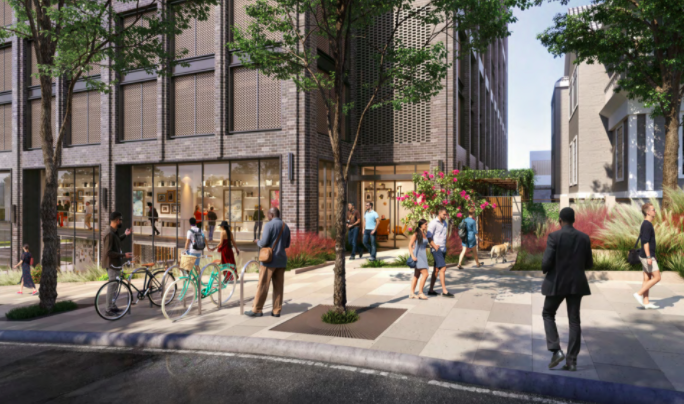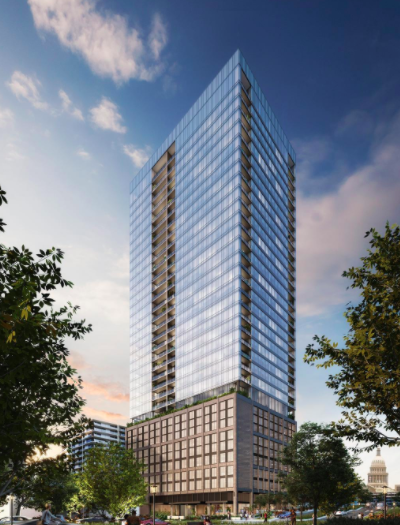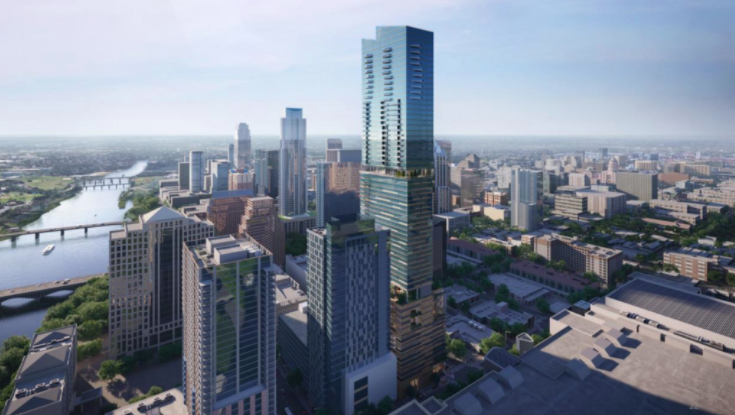Developers Stratus Properties Inc. and Intracorp Texas have each moved a step closer to building a new tower in downtown Austin.
Austin-based Stratus (Nasdaq: STRS) is planning a 400-foot residential tower near the Texas State Capitol, while Intracorp Texas wants to develop a 65-story hotel and condominium tower near the Austin Convention Center. Both projects would reach those heights under the city’s popular Downtown Density Bonus Program, or DDBP, which is used to add height to buildings in exchange for on-site affordable housing or fees that pay for such housing elsewhere, called fees-in-lieu.
The Austin Design Commission considered the plans at its Feb. 28 meeting and agreed that Stratus’ project substantially complied with the city’s urban design guidelines. Intracorp’s project did not receive enough votes to garner a recommendation from the commission, though it will still move on to Austin City Council next for consideration.

The proposals also come while the city is in the process of recalculating fees for the DDBP. Interim fees were adopted in May, including an $18 fee per bonus square foot for commercial developers after previously not requiring a fee at all; most residential fees also went up. Recalibrated fees are expected this year.
Austin’s tight housing market and rising affordability concerns are a focal point for the region, making affordable housing contributions a priority for the city.
Annie B
Stratus’ planned residential high-rise would include 316 apartments, parking and ground-floor amenity space with an art gallery, according to city documents. Plans call for eight floors of parking space and 25 floors of residential use.
Stratus is seeking a density bonus to boost the allowable floor-to-area ratio from 5:1 to 15: 1, which would add more than 345,000 square feet to the project, according to city documents.

The tower, called Annie B, will replace the headquarters of Austin-based Delta Kappa Gamma Society International at 416 W. 12th St., which will be demolished under the plans, according to past ABJ reporting. The project is named after Annie Blanton, the first woman elected as president of Texas State Teachers Association and first woman elected to statewide office in Texas. Blanton was also one of the founders of Delta Kappa Gamma.
The developer plans to restore the A.O. Watson house, which is a Victorian-style mansion adjacent to the tower site. The restored building, currently home to law firm Allison Bass & Magee, will include a restaurant, pool and garden. It was built in 1894 as the private residence of local architect Artur Osborn Watson, according to city and historical documents.
There will also be a train stop across the street from the project, part of Capital Metropolitan Transportation Authority’s $7.1 billion transit network expansion called Project Connect.
In exchange for the density bonus, Stratus plans to pay a fee-in-lieu of $2.8 million, project representative Michael Whellan of Armbrust & Brown PLLC said at the meeting.
Commissioner Samuel Franco questioned why the developer is opting to pay a fee-in-lieu instead of adding on-site affordable units.
“The cost of building a structure like this is extraordinary, and the $2.8 million can go a lot further, frankly, in other properties throughout the city,” Whellan said, adding there are other parts of the city that are much further behind in building affordable units.
The city of Austin adopted a Strategic Housing Blueprint in 2017, a 10-year plan to build 135,000 new housing units in the city by 2028. Of those new units, 20,000 were to be affordable to residents earning less than 30% of the median family income level. Most of the units, 75,000, would be affordable to those earning more than 80% MFI.
The city’s scorecard shows that fewer affordable units are being built in areas such as West Austin.
Franco said he wants to see more developers explain why the numbers wouldn’t work and to show an attempt to make units more affordable.
“If we don’t start trying to address that issue, or if we don’t start thinking of new solutions to it, we’re not going to come up with them,” he said.
Stratus Properties owns the downtown W Austin hotel. It has completed a wide variety of developments, from strip malls to suburban apartment complexes.
307-319 E. Second St.
Intracorp Texas, a division of Vancouver-based Intracorp Homes, wants to develop a high-rise off Second and Trinity streets that combines residences with a hotel and retail uses.
The tower calls for 135 condos, 326 hotel rooms and about 11,000 square feet of ground-floor retail and restaurant space, according to city documents. There will also be space for hotel and condo amenities. Intracorp Texas president Brad Stein was unable to disclose the hotel partner by publication time.

Renderings presented to commissioners Feb. 28 show how the 65-story skyscraper would tower over much of the skyline on that side of downtown. Intracorp leaders told ABJ that new renderings will be made public soon.
Currently, the tallest building in Austin is The Independent at 58 stories tall, although the Sixth and Guadalupe tower under construction will be 66 floors.
In order to build its project as planned, Intracorp is asking for a density bonus to raise the FAR from 8:1 to 25:1, which would essentially allow an additional 390,000 square feet. In exchange, Intracorp will pay nearly $4.8 million in fees-in-lieu of affordable housing, and it also plans to relocate a historic home currently at 307 E. Second St. to East Austin.
A few commissioners noted during the meeting that they would have liked to see on-site affordable units instead of fees-in-lieu, which has been a reoccurring conversation in Austin as affordability concerns run high.
Commissioner Jen Weaver, an Austin-based developer, said this is a conversation that the development community needs to have with the city of Austin.
“There are different reasons why a developer may not choose to participate in ‘capital A’ affordable, having to do with different types of managers, different types of financing, different types of property managers … when we talk about slipping in a few units, are we really properly serving ‘capital A’ affordable users when we don’t have that infrastructure properly set up?” Weaver said. “I just want to take a little heat off this applicant and redirect the conversation to: how can we … work toward better solutions that are feasible for everyone?”
The Article is from Austin Business Journal, copyright belongs to owner

